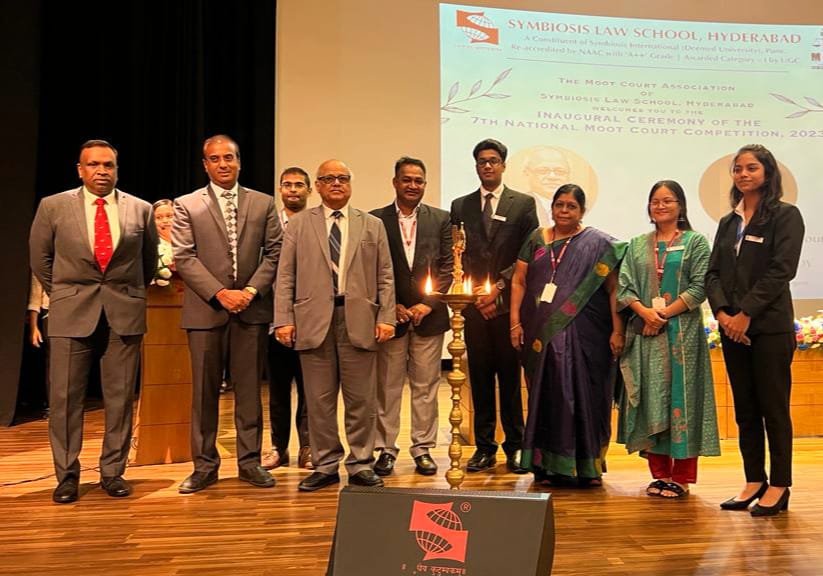Greetings Everyone!
Symbiosis Law School, Hyderabad welcomes you to the 7th National Moot Court Competition, 2023 live blog. The competition will commence on the 7th of April 2023, in collaboration with Eastern Book Company and SCC Online as Knowledge Partners, Lawctopus Law School as Educational Partner, and Lawctopus as Media Partner.
This year the competition will be conducted through offline mode. A total number of 21 teams are participating in the oral rounds after the qualification through the memorial rounds.
The event will include a total of 4 rounds i.e., Preliminary Rounds 1 and 2, Quarterfinals, Semi-Finals, and Finals.
THEME– Data Privacy, Information Technology Laws & Constitutional Law
In a world with dynamic advancements in the technological arena, the need for law to evolve with such developments is incessant, to meet the demands of society. It is in this regard, that SLSH is desirous to bequeath to the novice law aspirants an opportunity to deliberate upon such areas of law, in consonance with the Constitution.
DAY 1: 07th April 2023 (Friday)
3:30 PM – The Inaugural Ceremony has begun.
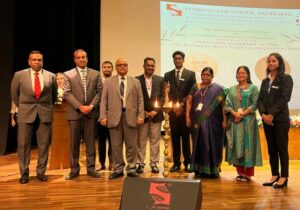
We are honoured and delighted to announce the 7th National Moot Court Competition 2023, hosted by Symbiosis Law School, Hyderabad.
We are privileged to formally welcome you to the 7th Edition of the National Moot Court Competition, 2023, the flagship event of Symbiosis Law School, Hyderabad.
For the Inaugural Ceremony, there were magnificent opportunities to interact with, and be inspired by legal luminaries and industry titans of the highest class, including:
Hon’ble (Former) Justice Mr. Pinaki Chandra Ghose of the Supreme Court of India – CHIEF GUEST
His Hon’ble (Former) Justice was appointed as a Permanent Judge of the High Court of Calcutta in 1997 and was nominated as a Member of the Central Authority of the National Legal Services Authority in 2011. Additionally, his Hon’ble (Former) Justice is also the Chancellor of NALSAR Law University, Hyderabad.
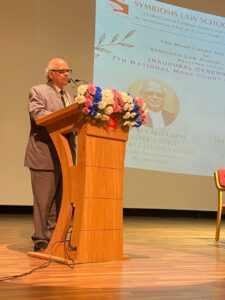
Hon’ble Justice Vijaysen Reddy of the Telangana High Court – GUEST OF HONOUR
His Hon’ble Justice was elevated as a Permanent Judge of the High Court for the State of Telangana and assumed charge in 2020.
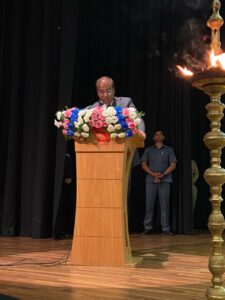
The Inaugural Ceremony has concluded. Participants gathered for refreshments.
5:30 PM – The Draw of Lots has begun.
The teams have started drawing the lots for the 7th NMCC. The competition briefing has begun, and the courtrooms for the oral rounds have been assigned by the organizers.
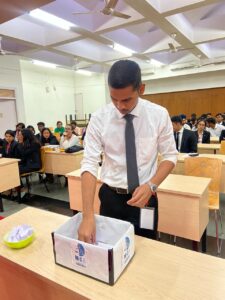
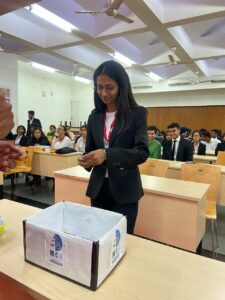
The Draw of Lots has been successfully completed, and the teams have been allotted their parties to represent. We shall reconvene tomorrow for the main sessions.
DAY-2: 08th April 2023 (Saturday)
8:30 AM – The panel of Judges has arrived. The Participants and Judges have made their way to the breakfast.
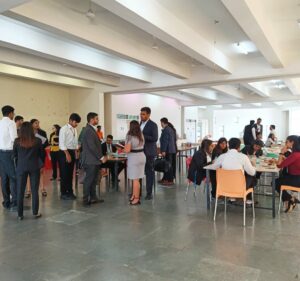
The long-awaited day has finally arrived. It would be followed by the Preliminary Rounds 1 and 2 and will be continued by the quarter-finals.
9:30 AM – The proficient key team of the Moot Court Association has successfully started the Judges’ briefing by highlighting the crucial details of the moot proposition along with explaining the key memorial.
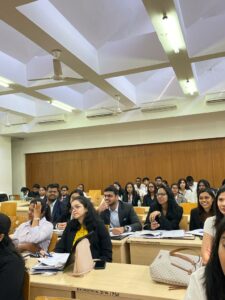
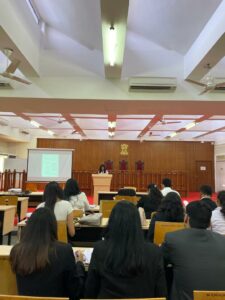
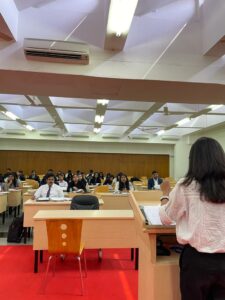
The engaging session paved the way for the forthcoming sessions.
PRELIMINARY ROUND 1 – 10:30 AM – 12:00 PM
Court Room-1 [TN_714_PET v. TN_717_RES]
Participants arrived in the courtroom. They have seated themselves and are reviewing the memo one last time. The judges walk into the courtroom and start reviewing the case. The speakers of the Petitioner’s side have begun with the oral arguments. The first speaker from the Respondent’s side has taken over to proceed with the remaining issues. The rebuttals and sur-rebuttals have begun after the conclusion of the Arguments Advanced. After the conclusion of all rebuttals and sur-rebuttals, both teams depart the courtroom.
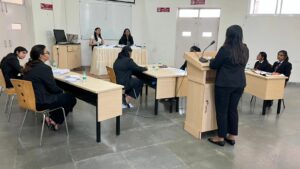
Court Room-2 [TN_710_PET v. TN_716_RES]
Judges, participants, and the support committee have all arrived. Oral arguments have begun now. Speaker 1 for the Petitioner side has pleaded for 13 minutes, and Speaker 2 has taken the dais. His earlier stated duration was 15 minutes, but speaker 1 changed the time period by one minute, making it 14 minutes. He will now speak for 13 minutes. The second speaker went on for an additional three minutes, but the Judges only allotted one minute of that time. The Respondent has now arrived at the dais. The first speaker is taking 14 minutes to speak. They are speaking for 16 minutes without a judge-provided extension. The second speaker has taken her place at the podium. She is speaking for 14 minutes, addressing problems 2, 4, and 5. Speaker 1 covered issues 1 and 3. The Bench granted speaker 2 a one-minute extension.
The rebuttals are currently being presented by the Respondent for two minutes. The Petitioner decided not to object. The Respondent requested an extra minute. The Respondent has withdrawn their counter-arguments. Following the Petitioner’s statement, the Respondent continues to dispute the petition for a further six minutes. When time ran out, the Petitioner sought to respond to the Respondent once again, but the Bench denied the request. The session ended successfully.
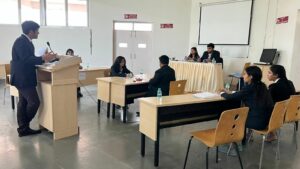
Court Room-3 [TN_718_PET v. TN_705_RES]
Participants and Support Committee have entered courtroom 3 for signing. The Petitioners’ first speaker began the session by outlining their points of contention. Judges asked questions, and they gave concise answers. Speaker 1 introduced issue 2. Judges granted extra time to Speaker 1 to complete his contentions. Speaker 2 has begun with the issues. Speaker 2 moved on to issue 4. Speaker 2 is responding to queries from the judges. The Judges approved 2 minutes for issue 5.
Speaker 1 of the Respondent’s side made his opening statement. The speaker was given a two-minute extension by the Judges. The second Respondent speaker has begun to argue. Judges are questioning, and simultaneously it is being answered by Speaker 2 with clear statements. Rebuttals from the Petitioner’s side and sur-rebuttals from the Respondents have been initiated. The session concluded with an intense round of arguments.
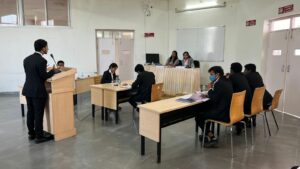
Court Room-4 [TN_708_PET v. TN_721_RES]
As the proceedings are in progress, the Petitioner’s first speaker began by stating the facts. The first speaker put a stop to the argument. The Petitioner’s second speaker began presenting their contentions, and the speaker concluded their contentions. The Petitioner presented their prayer. The points were brought up by the Respondent’s first speaker. The second speaker went on to address more issues. The prayers of the participants have spoken aloud. The Petitioners presented the rebuttals. The session ended with the Judges marking the marksheet.
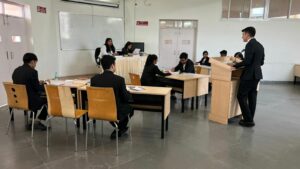
Court Room-5 [TN_706_PET v. TN_722_RES]
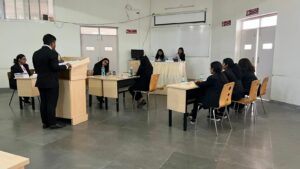
Court Room-6 [TN_719_PET v. TN_711_RES]
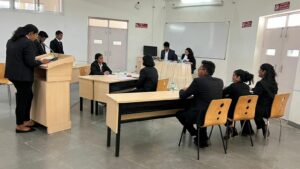
Court Room-7 [TN_709_PET v. TN_707_RES]
The session has commenced. The first speaker has begun their oral arguments. The Judges granted a two-minute extension. Speaker 2 has begun their opening remarks. Speaker 2 went beyond his allotted time. Speaker 2 read the prayer after concluding the arguments. The Respondents have started with their pleadings, and the Judges have begun a tough line of questioning. Speaker 2 has begun the oral pleading. Speaker 2 requested an additional two minutes. Judges extended the time limit for the Prayer. Petitioners’ (Speaker 2) rebuttals have begun. The Judges granted a 20-second extension. Respondents (Speaker 1) began by offering their sur-rebuttals. Round-1 has finally concluded.
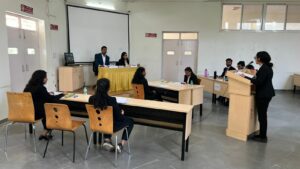
Court Room-8 [TN_701_PET v. TN_720_RE]
The Judges arrived in the courtroom, and the courtroom master read the rules and regulations. The session began with the due permission of the Bench. The Petitioner seeks permission to start the pleadings, and the Judges have now raised interest in questions towards the Petitioner’s counsel. The council of the Petitioner seeks help from the researcher. Petitioner counsel now begins with the issues. Speaker 1 is still being questioned. Speaker 2 begins with their argument. The Bench asked them to summarize the issue. The Respondent’s counsel begins with the argument. Speaker 1 of the Respondent side concludes, and Speaker 2 takes over. Speaker 2 is asked to conclude issues 2 and 6. The Respondent’s side stands for the prayer. Petitioner’s side start rebuttals. The session ends.
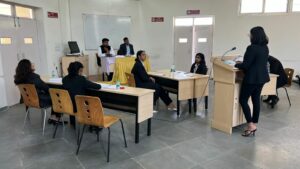
Court Room-9 [TN_715_PET v. TN_713_RES]
The contestants entered the courtroom and take their seats. The Petitioners began presenting their cases five minutes into the competition. The Judges went into depth about questioning speakers. The speaker was caught off guard by the question, but they recovered thanks to their teammate’s ordeal. The discussion lasted for 35 minutes. The Petitioner’s side Speaker 2 has arrived at the dais. The Respondent’s side began arguing after an hour and 20 minutes. Their presenters appeared to comprehend the inquiries and were eager to focus them on the topic the Judges were trying to seek. Despite being equally questioned, they managed to survive the war. Overall, it was a fascinating and engaging round.
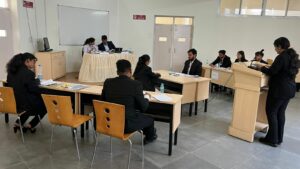
Court Room-10 [TN_704_PET v. TN_703_RES]
The Petitioner started with the contentions. The Judges filed two questions in two minutes. The Bench gave 5 minutes time to fully explain, and Speaker 2 acted on Issue 1 and Issue 2. She was instructed to move at a little slower pace. When there was one minute left in her speech, she halted at Issue 4, and an additional five minutes were given. The prayer was then said. Speaker 1, the Respondent, has provided their time division. The Judge had a lot to say regarding the Right to Privacy. They were given an additional five minutes of time. Speaker 2 addressed the third concern. The session continued with the rebuttals and sur-rebuttals. The session ended on a great note.
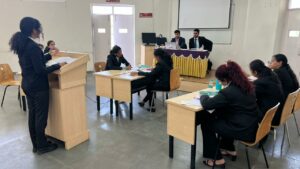
Court Room-11 [TN_702_PET v. TN_712_RES]
The pleading party began. Speaker 1 has arguments to support them and began with their issues. The speaker became a little flustered by questions that the Bench asked during the arguments. The Judges instructed the presenters to answer the following question. With the help of the Courtroom Master, the Judge distributed the Bare Act to the Speakers. The Judge directed the speakers to continue with the predetermined topic. The first speaker has one minute to finish their argument. The speaker did not ask for an extension. The Researcher gave Speaker 1 a note. Speaker 1 was questioned about the issues, and the speaker claimed ignorance. The speaker took 7 minutes 34 seconds in excess of the allotted time. Speaker 1 began by stating their contention with assurance. The Judges asked Speaker 1 a series of questions. The Researcher handed over a chit to Speaker 1. The Speaker responded to repeated questions and proceeded with the prayer. The Respondent began their arguments. The Judges were given access to the compendium. The speaker stumbled a little bit between their arguments and seemed a little bewildered by the questions being asked. Speaker 2 received a question and answered it. The Judge directed the speaker to proceed with their arguments. Speaker 1’s argument did not persuade the Judge. The Judge challenged the speaker to make a distinction between the two problems. The specifications were satisfied. The Judges moved on to the next question. The speaker presented the arguments and addressed the bench respectfully. Officially, 10 minutes remain. The second issue was addressed by the speaker. The speaker answered the questions with ease, and the answers nearly persuaded the Judges. The prayer was presented by the Respondents. The Petitioner’s rebuttals have already started. There is one minute remaining in the Petitioner speaker’s argument. The Respondent’s sur-rebuttals have already started. The session concluded with ease.
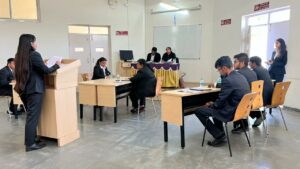
The first preliminary round has ended. After a short lunch break, let’s commence our second preliminary round. Stay tuned!
12:30 PM – The Panel of Judges have now arrived for their lunch!
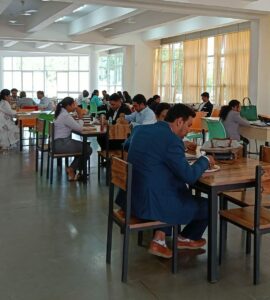
PRELIMINARY ROUND 2: 1:30 PM – 3:30 PM
Court Room-1 [TN_716_PET v. TN_718_RES]
Judges enter the courtroom. Both the teams have settled down in their respective places, and the Judges are going through the memorandum. The session has started, and Petitioner has started with their arguments. The time is up for speaker 1, and the Judges have allowed for an extension of time. Speaker 1 is done with their argument. Speaker 2 is presenting the issue. Petitioners are done with their arguments, while the Respondent started with their arguments. Respondents are also done with their arguments. Rebuttals have started. All the rebuttals and sur-rebuttals are over. The session has thus ended.
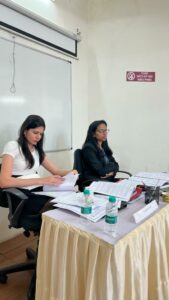
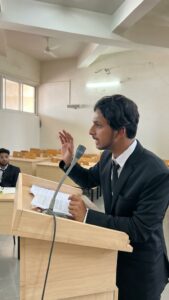
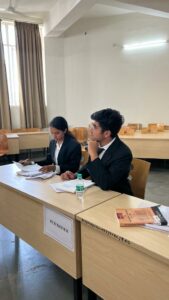
Court Room-2 [TN_705_PET v. TN_708_RES]
The session has started. The Judges have arrived. All the formalities have been taken care of. Now, the Petitioner’s side speaker 1 has arrived at the podium. He has taken his time of 15 minutes to speak. 3 minutes of the time has been deducted from the time of speaker 2 and added to the time of speaker 1. And now, he has taken 18 minutes for oral pleadings. He took 2 minutes extra, without the extension given by the Judges. Speaker 2 has come to the podium. He has 10 minutes for oral pleadings. He has taken 3 more extra minutes. The Respondent has taken over. First, speaker 2 is dealing with issues 1 and 2 with 14 minutes of time. And 2 minutes of extension have been given by the Judges to speaker 1. Now, speaker 1 has arrived to the podium. He has in total 16 minutes, including the extension of 2 minutes given by the Judges. He got 2 minutes and 30 seconds of extension from the Judges for concluding the last issue. Petitioner got 2 minutes for rebuttal after that 1-minute extension has been given. Now, the Respondent is there for 2 minutes to answer the rebuttals. Petitioner got strictly 1 minute again to put his arguments, and after that strict one minute was given to the Respondents, and the case was closed.
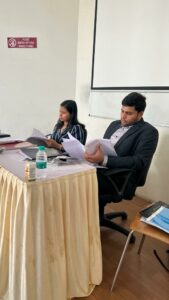

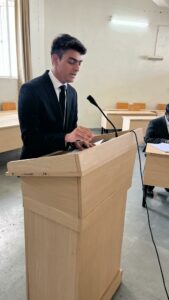
Court Room-3 [TN_721_PET v. TN_706_RES]
Speaker 1 for the Petitioners opened the discussion when the session began. The speaker is addressing the questions that the Judges are asking with confidence. The conversation has progressed to a debate. Judges have approved Speaker 2’s motion. The Judges object to a presentation of arguments that restate memorialised facts. Judges are intensively questioning Speaker 2. Respondent Speaker 1 has begun presenting his points. Speaker 1 shifts to his second argument. Speaker 1 received additional time to present the case’s arguments. Speaker 2 has become engrossed in the arguments. The Judge’s queries and the speaker’s strong arguments led to a 5-minute extension only. Speaker 2 has raised some problems. The session concluded with rebuttals from the Petitioners.
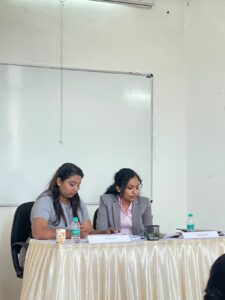
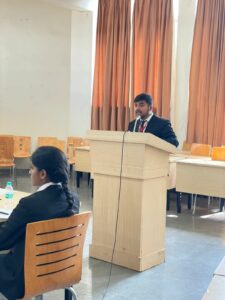
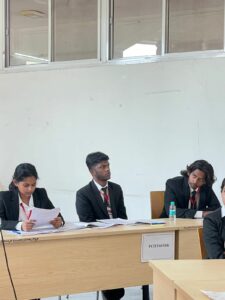
Court Room-4 [TN_722_PET v. TN_719_RES]
The proceedings have begun. The Petitioners’ first speaker launched into their justifications. The arguments are over. The second speaker made their case. Speaking out loud, Petitioners prayed. The Respondents’ first speaker presented their positions. The second speaker presented their contentions. The Petitioner offered their arguments in opposition. Following their conclusion, the Respondents gave their counter-arguments. The session has been concluded.
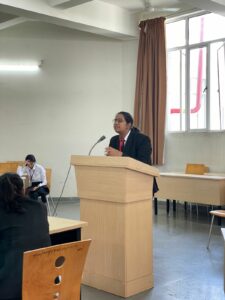
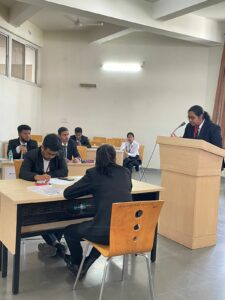
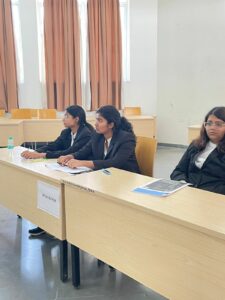
Court Room-5 [TN_711_PET v. TN_709_RES]
Judges have entered for preliminary round 2. The courtroom master reads the script. Speaker 1 from the Petitioner’s side proceeds with his issues. An extra time of 5 minutes was allotted. His co-counsel begins, and 2 minutes of extra time was provided, to sum up the issue. Counsel for the Respondents has started with their issues, and the second speaker concludes. Speaker 2 of the Respondents’ side also concludes her issues. Judges question the second speaker, and the session ends.
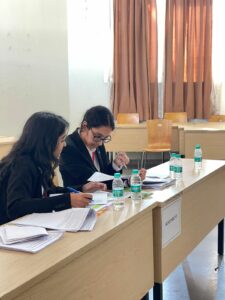
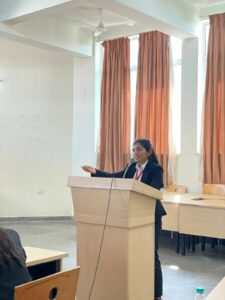
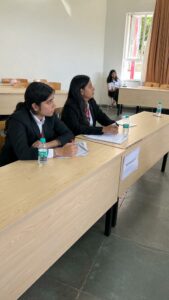
Court Room-6 [TN_707_PET v. TN_701_RES]
The Petitioner’s side’s first speaker begins the discussion by outlining their points. Speaker 1 has finished making his arguments, while Speaker 2 has just begun. The Petitioners’ Prayer is being said. While the Judges are asking questions, the Respondents begin their arguments. The speaker responds to queries while continuing his arguments. The Petitioners begin to refute. The Respondents begin their sur-rebuttals The session is over.
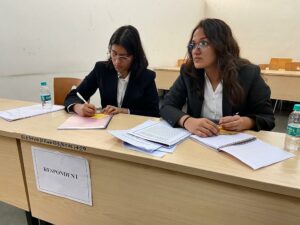
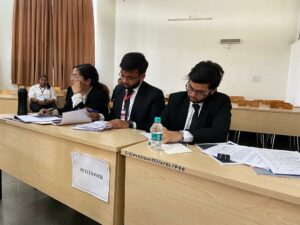
Court Room-7 [TN_720_PET v. TN_715_RES]
The session has started. Speaker 1 has begun their oral arguments and will address points 1 and 4. Speaker 1 went beyond their allotted time. Speaker 2 has begun speaking and will be addressing topics 2 and 3. Speaker 2 has gone over their allotted time. A 5-minute extension has been given by the judges. Speaker 2 has gone over their allotted time. Judges have granted an additional 30 seconds. Respondents’ oral arguments have begun, and Speaker 1 will be addressing Issues 1 and 2. Speaker 1 has exceeded their allotted time. The Judges have granted a further 5 minutes. Speaker 2 has begun their oral arguments and will address topics 3, 4, and 5. Speaker 2’s time limit has been reached. The Judges have granted a 1-minute extension. Petitioners’ Speaker 2 has started with their rebuttals. Respondents’ Speaker 2 has started speaking, and the sub-rebuttal session is now over, and the session has been concluded.
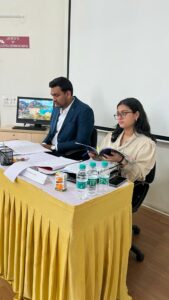
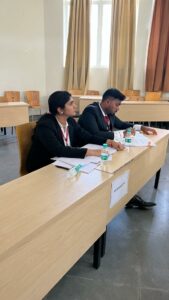
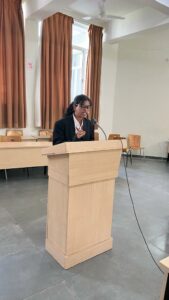
Court Room-8 [TN_713_PET v. TN_704_RES]
The courtroom masters have read out the rules and regulations while the participants and the respected Judges have all been seated in the room. The Petitioner’s concern was questioned by the Bench because it was inconsistent with their prayer, to which the counsel claims ignorance. The speaker is questioned by the Bench as to how the Petitioner’s views were sought. The Petitioner’s memorial is read by Speaker 1 of the Petitioner’s counsel. The Bench requests that petitioner’s counsel 1 wrap up issue No. 2 and list the issues raised in each memorial. The arguments are to be concluded by the counsel. When Speaker 2’s allotted time was up, the Bench asked questions about the prayer. The counsel of the Respondent supported their claim. The Respondent stand up for their prayer. Rebuttals take place, and the session concludes.
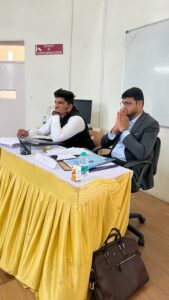
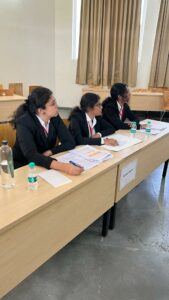
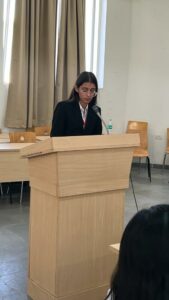
Court Room-9 [TN_703_PET v. TN_702_RES]
The session rules are explained in detail. The Petitioner’s first speaker begins to contend. The Judges probe the first speaker. Speaker 1 makes a confident start while elaborating on the Judges’ questions, but the replies fail to meet their expectations. Speaker 1 is responding to the same query that was posed to her. She summarises issue 1 afterwards. when a prolonged exchange between the counsels, the co-counsel assumes control when the speaker from the Petitioners’ side is bombarded with multiple questions. Speaker 2 is bewildered by the questions posed, but the Judges are won over by her responses. The Respondent has started arguing. The Respondent’s second speaker has begun debating. The Judges begin asking questions to the speaker. The speaker almost made a contradicting statement in response to the Judge, almost causing the argument to take a turn, but, he refrains, leaving the Judges satisfied. She heard them pray. Each team begins with a rebuttal and a sur-rebuttal. The Judges exit the courtroom when the session is over.
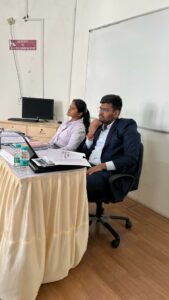
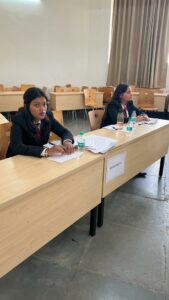
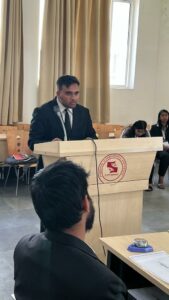
Court Room-10 [TN_712_PET v. TN_714_RES]
When the Judges entered, the regulations were read aloud. The Petitioner’s Speaker 1 indicated during the session that the case’s facts had been stated. Judges give a 1-minute extension of time. She was able to satisfy arguments in Issue 1 because the Respondents started with it. The Judges move on to issue 2, and a 3-minute of extension is provided to the speaker. Speaker 2 from the Respondents’ side has proceeded with issue 2. They completed their prayer and answered the Judges’ questions. The rebuttals are over, and the session has ended.
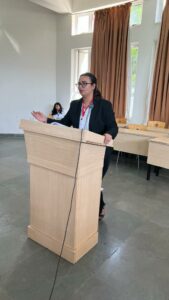
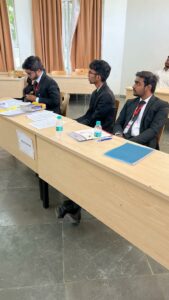
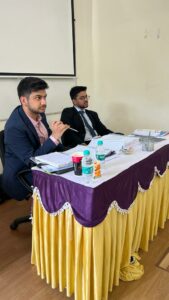
Court Room-11 [TN_717_PET v. TN_710_RES]
The speaker has begun by extending greetings. The speaker has been addressing issue 1. The speaker began with their justifications and oral arguments. Questions from the Judge were directed towards speaker 1. The speaker answered a query from the Judge by mentioning their Researcher. The Researchers gave chits to speaker 2, and speaker 2 has a few minutes left. For a question, the speaker professed ignorance. The Judges did not allow the speaker to respond to their queries. The Judges requested that speaker 2 go on to the following topic. There is still one minute left in the speaker’s presentation. The question was posed to the speaker by the second judge. Time is up.
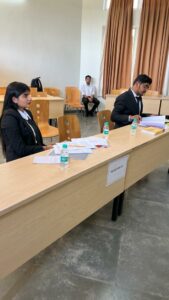
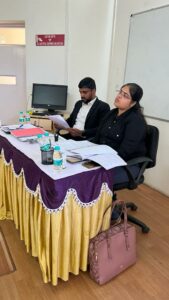
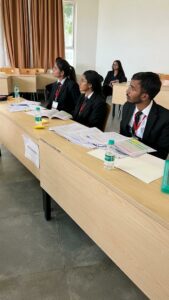
We have come to the conclusion of the Preliminary Rounds 1 & 2. The results of the Preliminary Rounds and the Draw of lots for the Quarter-finals are scheduled from 6:00 PM to 6:30 PM.
3:30 PM – Appreciation of the Judges of the Preliminary & Quater-Finals was done by Dr. Santosh Aghav (Director, Symbiosis Law School, Hyderabad), Dr. Anuradha Binnuri (Deputy Director, Symbiosis Law School, Hyderabad) and Mr. Abhilash Sapre (Faculty-In-Charge, Moot Court Association, Symbiosis Law School, Hyderabad).
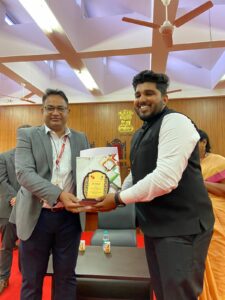
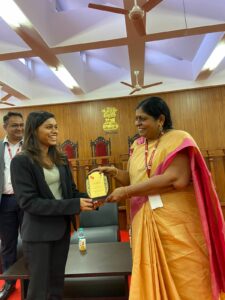
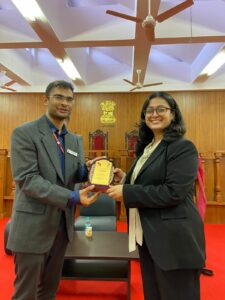
5:00 PM – By emphasizing the crucial components of the moot argument and providing a perspective for the quarterfinals, the knowledgeable core team of the Moot Court Association successfully opened the Judges’ briefing.
6:30 PM – We are delighted to announce that the Quarter-Finals Draw of Lots has been conducted, and we are pleased to reveal the top eight teams who will compete in the next round. The teams are qualified in the order of their cumulative scores in Preliminary Rounds 1 and 2.
- TN_708
- TN_703
- TN_718
- TN_709
- TN_712
- TN_720
- TN_717
- TN_706
6:40 PM – The teams are matched up in the following order:
|
COURT ROOM NO. |
PETITIONER |
RESPONDENT |
|
I |
708 |
706 |
|
II |
717 |
703 |
|
III |
720 |
718 |
|
IV |
712 |
709 |
We are glad to announce the commencement of the Quarter Finals Round.
QUARTER-FINALS: 7:00 PM – 9:00 PM
Court Room-1 [TN_708_PET v. TN_706_RES]
The Judges have taken note of the team codes assigned to the Petitioners and Respondents. The Judges are prepared for the session to begin. The session began with the rules and regulations being read aloud. The first speaker from the Petitioner’s side has mounted the platform and is delivering the case facts. The Judge asked the first speaker a question. The first speaker has been asked a question by the second Judge. 10 minutes have passed. Another question was raised. The first Judge posed another question. There are 5 minutes left. 1 minute and 30 seconds have passed. 30 seconds have been added to the timer. It’s showtime. The second speaker from the Petitioner’s side has concluded. The first speaker from the Respondent’s side has taken the podium. There are only 10 minutes remaining. The second speaker has taken the stage. 10 minutes have passed. Time is up, and the speaker has 1 minute to summarise the outstanding issues. Time is up, and the second speaker has concluded. Rebuttals have begun, with the first speaker from the Petitioners’ side using 2 minutes for rebuttals. The first speaker from the Defendants’ side has taken the podium for sur-rebuttals. A thank you note concludes the session.
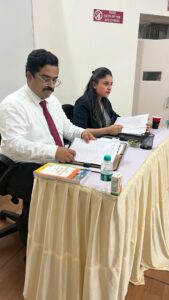
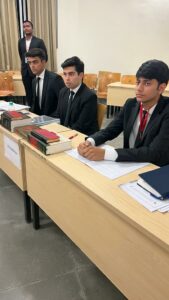
Court Room-2 [TN_717_PET v. TN_703_RES]
The participants have entered the courtroom. They’ve taken their places and are ready to go. The courtroom master finishes the introduction and reading of the rules. Petitioner speaker 1 requests permission to approach the dais and commences pleadings for 12 minutes. Judges have begun to examine Petitioner speaker 1, 2 minutes into the pleadings. The speaker continues with the arguments. The Judges question the speaker again about the invasion of privacy. The speaker is frequently questioned by the Bench. The Judges continue to scrutinize the Petitioners’ locus standi. Speaker 1 continues with the second and third arguments on Issue 1. The Judges ask the speaker again about the meaning of end-to-end encryption, and the speaker is given only 1 minute to continue arguing. The speaker’s time is over, but the Judges continue to interrogate the exemption afforded by Section 79 of the IT Act, and the speaker does her best to answer the Judges’ questions. 5 minutes have elapsed, and the Judges have bombarded the speaker with questions. She struggles to respond to the questions, but she does so with the benefit of time. Several chits have been passed between them. With permission from the Judges, Speaker 2 of the petitioner side enters. He is prepared to speak for 16 minutes. Speaker 2 is interrogated as soon as he begins his arguments. He is interrogated about their representation and prayer. After 3 minutes of questioning, the Judges ask the speaker to proceed with arguments. Speaker 2 has 10 minutes to submit his oral pleadings. The Judges interrupt the speaker and interrogate him on the gatekeeper’s liability and the rights granted by Articles 14 and 19 of the Constitution of India. The speaker continues with 1 minute remaining and summarises issue 5. Speaker 2 of the Petitioner side’s time is up. Speaker 2 recites the prayer. Respondent, with the approval of the Bench, enters the dais and commences her oral pleadings. She informs the Judges that Respondent Speaker 1 will address problems 1, 2, and 3 for a total of 16 minutes, and Respondent Speaker 2 will address issues 4 and 5 for a total of 12 minutes. After 5 minutes of questioning, the speaker was finally allowed to continue with her arguments. The speaker moves on to issue 2. The speaker has 1 minute to make her case. The speaker wishes for a time extension. The Judges continue to interrogate the speaker about the invasion of privacy by seeking data and grant the speaker a 1-minute extension. Another 30-second extension has been granted to the speaker. Speaker 1 leaves the podium. Speaker 2 comes and begins her statements. The speaker is questioned about the authority’s competence. The speaker gets 10 minutes to finish her appeal. The speaker is questioned on the infringement of rights. The judges continue asking the speaker about the request to complete an impossible condition and if it is an unreasonable order. After 5 minutes of questioning, the speaker is allowed to proceed to issue 5. The Judges ask the speaker once again about the legal rules for intermediaries and the punishment offered. Speaker 2 of the Respondent side’s time is out, yet the Judges continue to bombard the speaker with questions. As the barrage of questions continues, the Researcher passes chits to the speaker. The maximum time extension has expired, and the Judges have finished their barrage of questions. Speaker 2 recites the prayer. The Petitioners commence their rebuttals, and the Responders commence their sur-rebuttals. The quarter-finals session in courtroom 2 concludes.
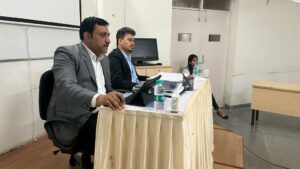
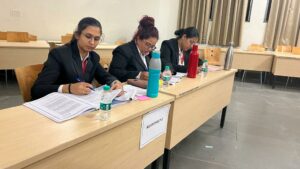
Court Room-3 [TN_720_PET v. TN_718_RES]
The session for the quarter-finals has begun. The Petitioner’s first speaker began by presenting the facts. Speaker 1 will be discussing topics 1, 4 and 5. The matter was raised by the first speaker. Following a series of queries from the Judges, Speaker 1 finished the issue. There is 1-minute remaining in the time given to speaker 1, and she is still dealing with issue 4. The Judges have granted speaker 1 an extension of 1 minute to conclude her points. Speaker 1 began with issue 5 and completed her remarks. Speaker 2 began with issues 2, 3, and 6. The Judge requests the facts of the matter cited by speaker 2 in her arguments. and speaker 2 states that she is unaware of them. The Judge grants speaker 2, a 3-minute extension because she has exceeded her time restriction. The Judges grant Speaker 2 another 4-minute extension. Speaker 2 will then begins with the prayer. Respondent 1 begins with the arguments. After successfully answering the Judge’s questions on the issue, Speaker 1 moves on to the next subject. Speaker 1 requests a 3-minute home extension, but the Judges only grant him a 2-minute extension. Speaker 1 concludes his points within the time allotted. Speaker 2 takes the stage and begins with the remaining issues. The counsel concludes their arguments. The Petitioner’s rebuttals and the Respondent’s sur-rebuttals come to an end, and the session concludes.
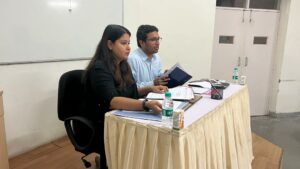
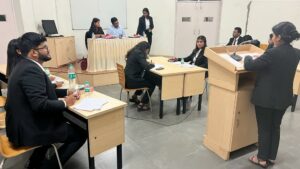
Court Room-4 [TN_712_PET v. TN_709_RES]
The session begins, and Speaker 1 of the Petitioners’ team presents his reasons. Speaker 2 is presently delivering their case. The Petitioners make their request. Respondents begin their arguments. Speaker 2 of the Respondents is making her case. Respondents are currently praying. With the completion of the Respondents’ arguments by Speaker 2, the Bench enables the parties to proceed with the rebuttals and sur-rebuttals. During the feedback session, the Judges emphasised the significance of time management and recommended participants to read the questions before answering. This brings us to the finish of the round.
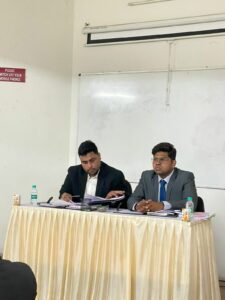
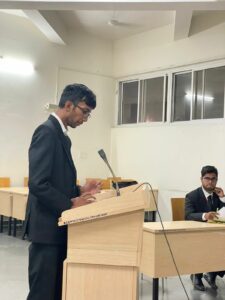
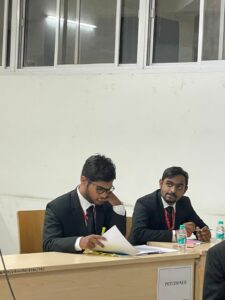
After the conclusion of the exhilarating Quarter-Final rounds, we will soon announce the top 4 teams that have qualified for the Semi-Final Rounds.
8:00 PM to 9:00 PM – Cultural Evening
A Cultural Evening was organized by the Cultural Troupe of Symbiosis Law School, Hyderabad. A number of exhilarating performances were organized for the participants.
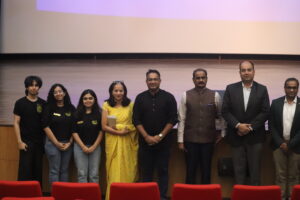
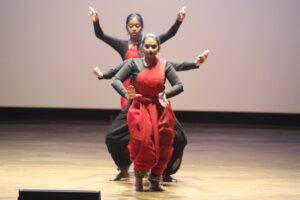
10:00 PM – Declaration of results of the Semi-Finals.
The teams which qualified for the Semi Final Rounds are:
- TN- 708
- TN- 718
- TN- 709
- TN- 703
Day 3: 09th April 2023 (Sunday)
8:30 AM – The Judges and participants have proceeded to breakfast.
9:00 AM – Briefing of Semi-Final Judges.
10:00 AM – 01:00 PM: SEMI-FINAL ROUNDS
Assembly Hall [TN_718_PET v. TN_709_RES]
Judges enter the courtroom. Both the team have settled down in their respective places, and the Judges are going through the memorandums. The session has started, and the Petitioners are going on with their arguments. The time is up for speaker 1, and the Judges have allowed for an extension of time. Speaker 2 is presenting their arguments. The Petitioners are done with their arguments. Respondents have started their arguments, and are done with their arguments. All the rebuttals and sur-rebuttals are over, and the Session has ended.
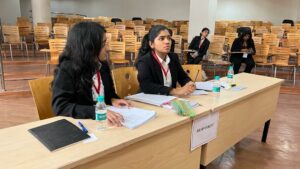
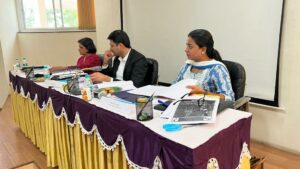
Moot Court Room [TN_703_PET v. TN_708_RES]
Judges have entered the courtroom, and both the team have settled down in their respective places, and the Judges are going through the memorandums. The session has started, and the Petitioners are going on with their arguments. In half an hour, the Petitioners are done with their arguments and asked for an extension of time. Next, the Respondents have started their arguments. In 20 minutes, the Respondents have completed their arguments, and the rebuttals and sur-rebuttals have concluded. The session has ended.
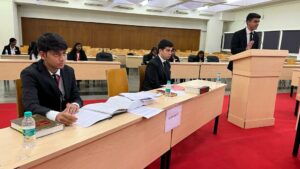
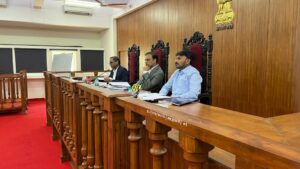
12:30 PM – The Judges and participants have proceeded to lunch.
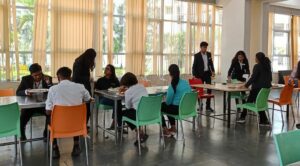
1:00 PM – The results for the Semi-Finals have been declared. The teams which have qualified for the finals of the 7th National Moot Court Competition are:
- TN_708
- TN_709
1:15 PM – Draw of lots have taken place for the final rounds where TN_709 has picked the Petitioner side and TN_708 has picked the Respondent side.
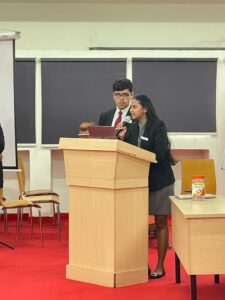
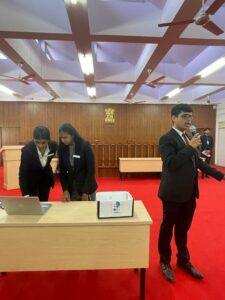
1:30 PM – Felicitation of the Judges of the Semi-Finals has been done by Dr. Santosh Aghav, Director, Symbiosis Law School, Hyderabad.
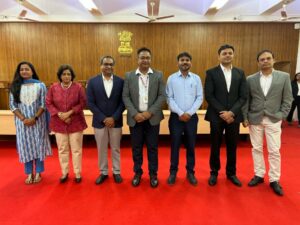
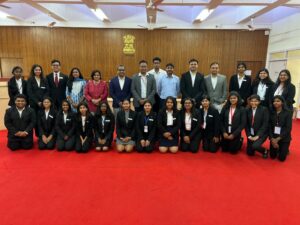
2:00 PM – The Judges for the Final Rounds of the 7th National Moot Court Competition have been briefed.
The Judges for the Final Rounds are:
- Hon’ble Justice Shri B.N Krishna Srikrishna, Former Supreme Court Judge and also headed the prestigious Sri Krishna Committee.
- Hon’ble Justice A. Ramalingeswara Rao, Former Justice of the High Court of Telangana and Former Judge.
- Hon’ble Justice G.A. Sanap, Sitting Judge of the Bombay High Court.
- Mr. Rodney Ryder, Advisor to the Ministry of Communications and Information Technology, Government of India, on the implementation of the Information Technology Act, 2000.
- Mr. Supratim Chakroborty, Senior Member and Partner at Khaitan and Co.
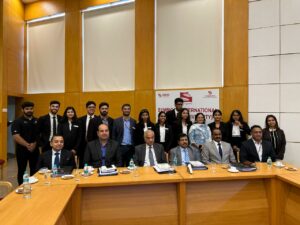
2:00 PM – 5:00 PM – FINAL ROUNDS
Auditorium [TN_709_PET v. TN_708_RES]
The Judges have entered the courtroom and sat at their respective places, meanwhile, the host was briefly introducing all the 3 Judges for the day! An introduction was also given to both teams. This escalated to the beginning of the first round, where the Petitioner’s side put forth their arguments.
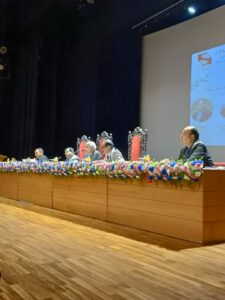
PETITIONER ARGUMENTS
- Initially starting with the statement of facts by Speaker 1. Then, moving towards the issue that Speaker 1 was covering.
- The Bench started interacting with the Speaker, asking questions while thoroughly analyzing their arguments.
- Whereas, smoothly answering the questions of the Judges, the Speaker carries on with their arguments. Moving on, Speaker 1 presents Issue 2 by seeking permission from the Judges. The Judges granted the permission, and the discussion over Issue 2 had taken place. Where the Judges asked numerous questions from the Speaker relating to Issue 2, and the Speaker easily answered every question that was asked by the Judges in the court.
- The Speaker then, moved towards their 2nd quarter of the arguments showcasing digital evidence which supported their arguments.
- Wherein, Speaker 1 pleaded for an extension of 5 minutes to present Issue 3, for which permission was granted by the Judges as the duration for speaking of the Speaker was up. The Speaker continued with their part of the arguments. Regards to which Judges had their doubts and respectively asked their questions from the Speaker.
- It ended, with Speaker 1 signing off and giving the mic over to Speaker 2, who presented the other issues i.e., issues 4 and 5.
- Before starting, the Speaker gave a small description of what issues 4 and 5 constituted just to give an idea to the Judges about the issues. Yet, the Judges asked several questions from the Speaker, and the Speaker presented their answers to them.
- To move ahead, she started with her set of arguments, while addressing legal provisions such as the Information Technology Act, 2000 to support her arguments in the court of law. Many case laws were also put forth in front of the Judges, suggesting them the many interpretations that can also be used in favour of their arguments. In response to this, the questions were also presented by the Judges, which were, however, answered by Speaker 2. The Speaker got a little flustered, yet she continued with her arguments, referring to Rule 20 of the IT Rules, of which she asked the Judges to take note as this was an important aspect of her arguments.
- Moving on, she then asked permission to speak about her next issue related to Article 21, which was granted by the Judges. The Speaker continued with her contentions, as the Judges had their doubts already. To answer it, she referred to many provisions of the IT Act and Rules. She concluded with her last 2 arguments referring to an international case that largely supported her set of arguments.
- To end with, she asked for permission to move ahead with the prayer.
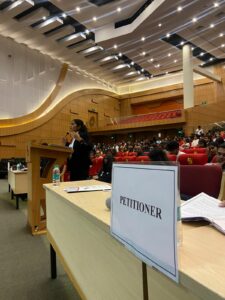
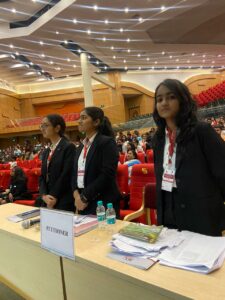
RESPONDENT ARGUMENTS
- The counsel for the Respondent took over the mic and seek permission to start with their set of arguments.
- Speaker 1 spoke about the issues that he will be covering, which were issues 3, 4 and 5 and started with his main part of the arguments while challenging the Petitioner’s part of the contentions of them claiming about misuse of power. Further, he challenged other contentions of the Petitioners by giving an example of case law regarding a national emergency.
- He also claimed the contentions to be misleading while referring to para 6 of the issue and asked the Judges to take a look by themselves. Therein, he explained Rule 12 of the IT Rules, where he stated the whole procedure of passing an order thoroughly to which the Judges raised their question regarding the contentions that were laid by Speaker 1. Furthermore, he answered and took into consideration what the Judges had to say.
- To move ahead, he started with his next issue and continued with his arguments as well as making the Judges understand every aspect of his arguments by giving several examples and with the help of citing legal provisions to support his argument. Simultaneously, challenging the Petitioner’s side of the arguments taking into consideration of Section 69 of the IT Act and relevant IT Rules. In regard to this, the Judges raised questions relating to the minute details of the issues that were covered by Speaker 1, to which, the Speaker answered while referring to his co-counsel who will answer the questions raised by the Judges as it was related to issues 1 and 2.
- Further, he continued with his arguments, referring to Rule 16 of the IT Rules and asking the Judges to read para 8 of the issue. Which, the Judges dropped numerous doubts and questions, which also got the speaker a bit distracted, yet he tried to answer the questions or doubts that were raised.
- Further, the Speaker pleaded for an extension of 5 minutes, which was granted by the Judges. As he continued with his arguments highlighting his major contentions, the Judges asked a tricky question which made the speaker more confused. Yet, he tried to answer, but the Judges looked half-convinced. After this, Speaker 1 concluded with his facts and left the space for his co-counsel.
- Speaker 2 walks in and presents his set of issues, i.e., issues 1 and 2.
- A question was asked by the Judges from the previous Speaker, which was actually covered by Speaker 2. To answer the previous doubt, he started off by referring to Section 8 of the IT Act 2000 to give an upright answer to the Judges, yet the Judges interrupted him, stating, “Fundamental rights are not to be tampered with.”
- Further, the Speaker still tried to keep his arguments straight, but the Judges were still not satisfied with the explanations provided. Additionally, the Speaker referred to the famous Maneka Gandhi case, in which the Judge claimed the security of a state is there for a specific reason or date. Specifically, cases relating interest of the state were referred to.
- Speaker 2 again continued with his part of the arguments, not claiming it to be a misuse of power and also mentioning case laws and legal provisions to support his arguments to which the Judges raised their question regarding public interest. In response to this, Speaker 2 talked about the concept of public order that was narrowed down in many cases earlier. He also referred to his co-counsel as he was also trying to prove every point.
- As the Judges hear this, they state about the general exceptions that have been narrowed down, claiming it to be the entire point that the counsel for the Respondent does not understand. Accordingly, Speaker 2 refers to the Puttaswamy case, where he gets interrupted by the Judges to speak more about the famous Maneka Gandhi case wherein, Speaker 2 thoroughly talks about it.
- Moving on, Speaker 2 asks for an extension which was granted by the Judges. As he goes ahead, he talks about the constitutionality that was upheld in the case and proceeds to issue 2. Therein, he stated the various legal provisions and Rule 16 of the IT Rules and Section 69 of the IT Act, to support his part of the arguments. Moreover, the Respondent briefly talked about data principle, and Section 20 of the DPDT Bill to support the contentions.
- Finally, the Speaker seeks permission to go ahead with the Prayer.
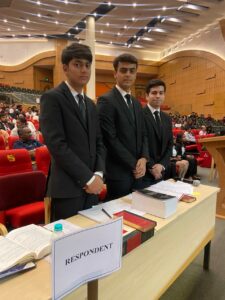
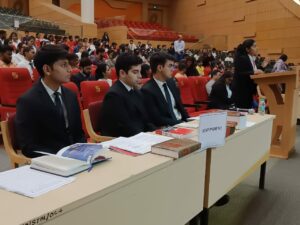
REBUTTALS
As the rebuttal begins, the Petitioner’s side goes ahead with their argument challenging the Respondent’s contentions, and he talked about the authentication of order, wherein, they read the legal provision to support their contentions. Further, they claimed the Respondent’s arguments to be fallacious. To conclude with the rebuttals, they stated that the Government cannot use citations as national security concerns should be justified.
SUR-REBUTTALS
To comply with this, the Respondent started with their round of rebuttals, referring to the first rebuttal of the Petitioner’s side as they claim they have not provided any data or any evidence to support their claim as they declare it to be an abuse of fundamental rights. He also continues by highlighting many records and metadata which supported their arguments and challenged the Petitioner’s contentions. With this, the rebuttals and sur-rebuttals round ended, and the host asked the Judges to proceed while moving out of the courtroom, and everyone stood up to show their respect to the Honorable Judges.
5:30 PM – The Valedictory Ceremony has commenced.
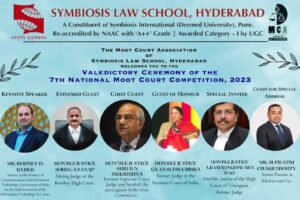
The Director of Symbiosis Law School, Hyderabad, Dr. Santosh Aghav, addresses the lively gathering. He acknowledges the presence of the Chief Guest, Hon’ble Justice Shri B.N. Srikrishna, and Guest of Honour, Hon’ble Justice Gyan Sudha Misra. He appreciates the efforts put in by the various Judges, Mr. Abhilash Sapre, Faculty-in-Charge of the Moot Court Association, members of the Moot Court Association, and the volunteers to make this event a success.
Keynote speaker Mr. Rodney D. Ryder, dedicated two words to the winners of 7th National Moot Court Competition – “Momento Mori“. He thanked Symbiosis Law school, Hyderabad for the invitation and is grateful to be in the same stage as the other eminent Judges.
Mr. Supratim Chakraborty, Guest for Special Address, thanked everyone for inviting him to be present in such significant competition. He felt honored to draft the moot proposition. He quoted, “Every teacher is student, and every student is a teacher.” He concluded by advising all the students “Be a student and as well as a teacher.”
Honorable Justice A. Ramalingeswara Rao, started off with greeting all the distinguished Judges and is happy to be back here again after 7 years. He introduced himself as a Senior Judge after 4 years of practice as a Senior Advocate in Supreme Court. He stated that the time has changed now with more challenging provisions and study of law is different from practice of law. He said that “the aim of law is not earning money but to render justice“, therefore he advised that we all should render justice to the needy people.
Honorable Justice Shri G.A. Sanap, felt pleasurable to be present here on the 7th National Moot Court Competition. He added that the moot court competition provides a valuable platform for legal skills. Learning the importance of ethics will help in the future career. He stated to be mindful being honest and respect the rule of law and the justice of law. He concluded by thanking all the organizers of the competition for setting up such a high level platform and opportunity for the participants to experience such competitions.
Honorable Justice Gyaan Sudha Misra, Guest of Honour, greeted all the guests that were present who did not need any introduction for such great personalities. She is delighted to be a part of the ceremony. She advised all the students to be tough and quoted “Spare the rod and spoil the child.” During her college days, she did not have such an opportunity to participate in moot court competitions and, therefore, was truly frustrated and delusional on things that were to be done in the court. Her father then advised her to sit in the court and watch the proceedings and the lawyer’s arguments. She did so and learnt a lot from it and is happy that we would not go through that stage of life and fortunate enough that we have many opportunities – law practice, judiciary, law firms, corporates, litigation, and public sector undertakings, among all. She ended her speech by stating that work hard and success will follow you.
Hon’ble Justice Shri B.N. Srikrishna, Guest of Honour, started by stating “Koshish karna humara kartavya hai“. He congratulated all the winners and gave his felicitations to those who participated in the competition, and that efforts should be commended and not the prize. He stated that he was deliberately harsh on the participants which prepared them to be in such intense situations. He suggested to draft least number of words with the quality matter, which helps to win over the Judges not only in litigation but also corporate advisors. He also advised not to ignore any point while arguing as it might be useful to convince the Judge. He spoke about Roman lawyer Cicero and famous United Kingdom lawyer who stated the three Cs should be followed by the upcoming generation – responsibility to the CLIENT, responsibility to the COURT, and CONSONANCE. He concluded by stating that every advocate should work as a social engineer and wished everyone to have a bright future.
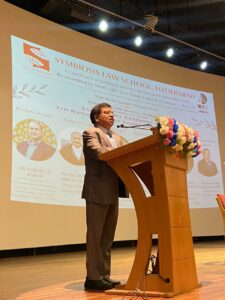
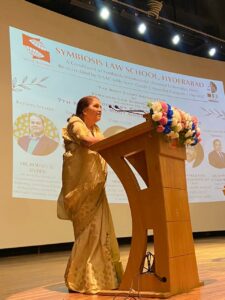
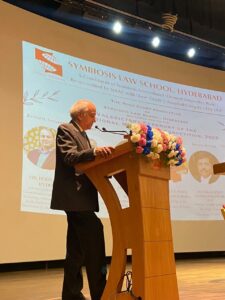
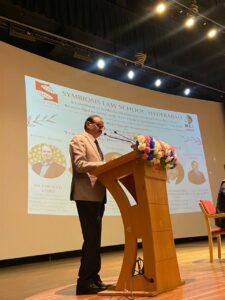
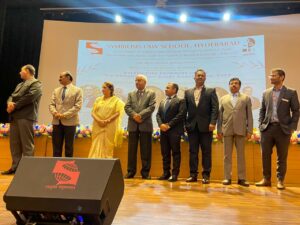
The President of the Moot Court Association, Mr. Vishvak Sunil, announced the results of the 7th National Moot Court Competition. And here, we present you with the winners:
- Winner: TN_708 [Symbiosis Law School, Noida]
- Runners Up: TN_709 [NUALS, Kochi]
- Best Memorial: TN_703 [Nirma University]
- Best Speaker 1: TN_708 [Symbiosis Law School, Noida]
- Best Speaker 2: TN_708 [Symbiosis Law School, Noida]
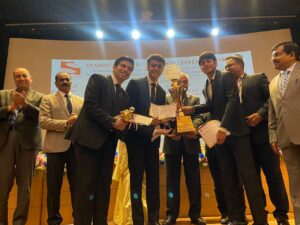
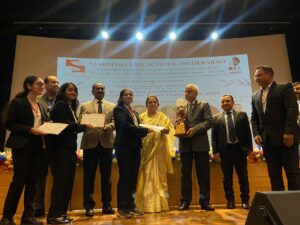
7:00 PM – Vote of Thanks by the President of the Moot Court Association
The President of the Moot Court Association, Vishwak Sunil, thanked the Director, Deputy Director, Chancellor, and Vice-Chancellor of Symbiosis International University. He expressed his gratitude towards the dignified Judges, participants, members and volunteers. A special thanks was mentioned to Mr. Abhilash Sapre, Faculty-in-Charge of the Moot Court Association for his support to have this successful event.
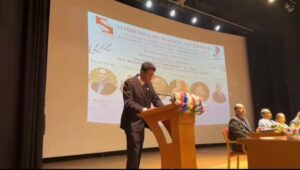
With this, we have come to the conclusion of the 7th National Moot Court Competition organized by Symbiosis Law School, Hyderabad. We extend our heartiest congratulations to the winners and appreciate all the diligent efforts put in by all the participants. We are elated that all the efforts of the organizing committee have made this event a resounding success. As we come to the end of this competition, we once again want to extend our heartfelt gratitude to all our dignitaries.



